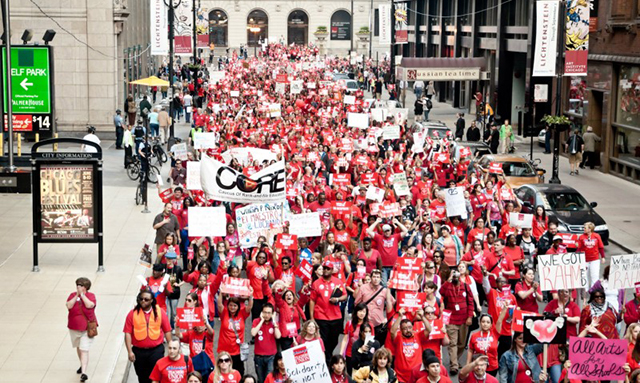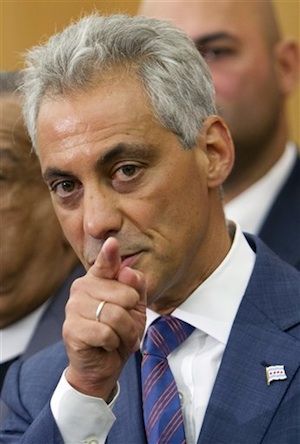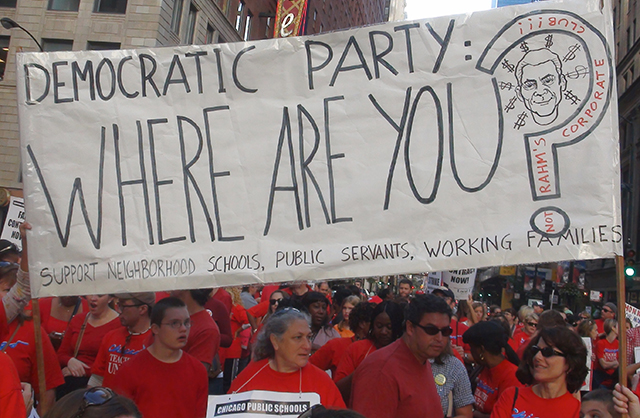by Rob Bartlett
October 23, 2014
It has been two years since the Chicago Teachers Union (CTU) struck for the first time in over 20 years and changed the discourse on education in the United States. The strike was historic in making issues of race and class central to a contract struggle and in garnering public support to defend public education.
The CTU strike confronted the attack on public education championed nationally by Arne Duncan, Obama’s Secretary of Education, and the national forces in favor of privatization, from the hedge fund-backed Democrats for Education Reform to billionaires like Bill Gates and Eli Broad. Still, the strike amounted to only one battle in a continuing war against public education. What has happened in the intervening two years, and what are the prospects for the next year as the CTU prepares for the expiration of its contract in June 2015?

A rally during the CTU strike in 2012.
A central goal of the “education reformers” has been to privatize public education by closing public schools and replacing them with privately run, publicly financed charter schools. In Chicago this process began in earnest in 2004 when the Board of Education, under then CEO Arne Duncan, adopted the Commercial Club of Chicago’s Renaissance 2010 Plan to close and replace “failing” public schools. By 2010, 80 public schools had been closed or “turned around” (a process in which the entire staff, from the principal to the lunch ladies, are fired) and replaced with 100 new schools, 70 of which are charter schools. In 2012, Chicago Public Schools (CPS) spokeswoman Becky Carroll (now head of Rahm Emanuel’s Super PAC) announced the intention to create another 100 new schools in the next five years.
Less than a year after the CTU strike, the unelected CPS Board of Education closed 49 more schools and turned around five public schools in the largest number of school closings in one year, affecting 46,000 students. The justification was ostensibly financial, as the board claimed that underutilized schools were draining money from an underfunded district and the consolidation of schools would save money that could be used to bolster the programs at receiving schools and across the district. A detailed analysis by the CTU research department shows that much of the money allocated to the receiving schools was spent on ancillary expenses like paying for the “Safe Passage” program that was established to protect students who are now forced to walk further to their receiving schools, often across gang boundaries.
Other promised improvements, such as libraries in each receiving school, were unfulfilled as 38% of the receiving schools are without the funding to pay for librarians. The alleged reallocation of resources turned out to be coupled with a reduction in funds for all public schools in the district, including the receiving schools, as the board went to a new “per pupil” funding formula that led to cuts of hundreds of teachers across the district and increases in class sizes. This new funding formula increased the amount of money going to charter schools by 12%, while money to neighborhood high schools was cut by 14%. Over 70% of CPS schools lost more than $100,000. At the same time CPS has spent or budgeted almost $200 million for the expansion of selective enrollment high schools located on the predominantly white north side of the city.
Black Education Gutted
The 2013 school closings mirrored previous closings in that they disproportionately affected Black and Latino communities, contributing to further destabilization of already impoverished neighborhoods. Of the closed schools, 71% had a majority Black teaching staff and 90% had majority Black students. Fully 25% of closed schools had both a majority of Black students and staff, while only 2% of schools with a minority Black student body were closed, according to the above-cited CTU report on school closings (see footnote 3). As a result African-American educators in Chicago as a percentage of the workforce have fallen from 41% in 2000 to 25% today.
The pattern of CPS actions to starve neighborhood schools in the poorest communities, while simultaneously building newer, better financed charter schools in those same communities, pushes students to enroll in the charters and further exacerbates the decline in the neighborhood schools. As a result neighborhoods like the west side community of Austin have no neighborhood high schools, while charter schools have a clear field to recruit.
Another example is the placement of Noble Street College Prep, a campus of the politically connected Noble Street Network of Charter Schools, directly across the street from Prosser High School. Prosser performs better than the CPS average in test scores on the PSAE, has a 20% higher graduation rate, and also sends a higher proportion of its graduates to college. It seems that Prosser is being set up to fail as it competes with the new $20 million Noble Street campus. (Rahm Emanuel is a big supporter of Noble, which also has a campus named for billionaire Republican candidate for governor, Bruce Rauner.)
In fact, immediately after the strike, Emanuel warned that up to 200 schools would have to be closed. The mayor’s threats did not go unchallenged, and the CTU led a campaign to link parents, communities, and educators in combined opposition to the CPS plan. Over 20,000 people attended hearings to oppose the closings, the largest number of people ever to do so. The union and its allies led two separate but concurrent three-day marches, starting on the Black south and west sides of the city and passing many of the schools slated to be closed. These marches gave graphic evidence of the lack of investment in neighborhoods littered with buildings that are boarded up and faced with demolition.
Still, the Board voted to close 49 schools and turn around five more. Three years earlier, when the board had threatened to close 22 schools, they faced opposition, backed down and six schools were saved. In contrast, in 2013 the Board spared only four schools which they had proposed to be closed, and one proposed for turnaround. Why the difference?
The level of community opposition to the closings was much higher in 2013 than in 2010, but as the stated reasons for school closings had changed from poor academic performance to the need to consolidate in the face of “underutilized” classrooms, the tactics of the board and mayor seemed to gain new intransigence, as they sought to impose a demoralizing loss of jobs on the CTU and an in-your-face to CTU’s community allies.
The major driver of the decision to close or turnaround over 50 schools was, first, to punish the CTU and their community allies in the wake of their successful strike; and second, to continue the privatization of education and to erode the union’s strength by driving more students into the expanding network of non-union charter schools. The unspoken message seemed to be that resistance is futile.
Political Polarization

Rahm Emanuel, “Mayor One Percent.”
The effect of both the 2012 strike and the 2013 struggle around school closings has been to increasingly isolate “Mayor One Percent” Rahm Emanuel, as public opinion polls show an increasing polarization in the city. A year ago 41% of poll respondents sided with the CTU while 19% supported Rahm; today the percentage of those supporting the CTU has grown to 62% while Rahm now has 23% support. In the Black community fully 79% support the union and only 9% support the mayor.
On charters versus neighborhood schools, the policy of the mayor is opposed by 72% and only supported by 18% of voters. The trend is once again even more pronounced in the Black community, with 83% opposed to closing neighborhood schools and funneling more money into charter expansion. Even more tellingly, 80% of parents of CPS students oppose his policy, including 63% of white respondents. These numbers show the extent to which the message of the CTU and their community allies has resonated with the public in Chicago.
The CTU and its allies have successfully framed the discussion around the need to have quality schools in all neighborhoods, pointing to the shift of resources from neighborhood schools to selective enrollment schools concentrated on the whiter north side and the expansion of funding to charters, which are demonstrably corrupt and politically connected—in the case of the United Neighborhood Organization (UNO) schools—or under investigation by the FBI (the Concept Schools, run by the Gulen organization).
While Rahm’s support is low in much of Chicago, many parents trust teachers and their union, whom they believe have their children’s best interests at heart. This led to the possibility that Karen Lewis of the CTU would run for mayor against Emanuel in the February 2015 election. Polls taken in August 2014 show that in a head to head matchup between Rahm and Karen, she had a 43% to 38% lead.
The sentiment among those who oppose Emanuel’s policies is that someone needs to run against him, and Karen was the person who could best catalyze that opposition and articulate the dissatisfaction with his policies. In early September, a training for Lewis petitioners brought out 400-500 people largely from a Facebook posting, showing that there is a sentiment that can engage people in mundane, but necessary, activities. There is enthusiasm present that an inspiring campaign run could generate.
It is virtually unprecedented that a union leader could challenge a sitting politician with as much national financial backing as his $8.3 million campaign fund shows. Such a campaign would have posed a myriad of questions and possibilities. What would be the thrust of the campaign? Could it help build the movement in Chicago against corporate policies? Could she win?
All those possibilities were in the air until her sudden hospitalization and surgery for a serious illness led to her decision not to run, announced October 13, a month before the deadline for filing petitions. This is a bitter pill for teachers and parents in Chicago and poses new questions for how the union and their allies will push their agenda in the February election and beyond.
The CTU strike and the movement that Karen represents shook the status quo and opened up the door for a revitalized movement of the African Americans and Latinos who make up 62% of Chicago’s population. In the years since Harold Washington won election as the first Black mayor of Chicago (serving from 1983 until his death in office in 1987) the political organizations that propelled Harold to run and led to his victory have declined in numbers and influence. In the wake of their decline Daley and Emanuel have had no trouble keeping minority aldermen in their pockets.
The issues of race and class that the strike and the school closings fights raised resonated with members of those communities and threaten to break the docility of the political forces in the Black and Latino communities allied to the Democratic machine. While the effects of education reform have struck hardest in those communities, even white parents have opposed the Mayor’s policies. In the wealthy Lincoln Park neighborhood parents have opposed a proposal to spend millions on an expansion of their elementary school, saying that the money would be better spent in poor neighborhoods.
Leading up to the strike and afterwards, parent organizations like Raise Your Hand, 19th Ward Parents, and Parents 4 Teachers—all predominantly white—vocally opposed the mayor’s policies and spoke out for adequate resources for all Chicago schools. The closing and starving of schools in the poorest neighborhoods contrasts sharply with the doling out of tax revenues, siphoned from the schools through Tax Increment Financing (TIF) zones, to wealthy entities like the Chicago Board of Trade, a luxury car dealership, $55 million to help finance a basketball arena, money to Hyatt Hotels, Walmart, and $60 million to build a new selective enrollment high school.
Broadening the Issues
A campaign by Karen Lewis could have pointed out the inequities between how the system treats the wealthy and the working class. Her exploratory campaign took up the demand of increased access to affordable housing, raising the minimum wage to $15 an hour, and raising tax revenue from the wealthy to pay for needed social services, as well as the campaign for an elected representative school board.
These demands by themselves are not revolutionary, but they are beyond the ability of the Democratic Party to grant, even if it weren’t engaged in a brutal campaign to slash pensions and healthcare for public workers. A successful challenge to the status quo would have to articulate the needs of Chicago’s communities, and consciously work to build those movements, if Chicago’s political landscape is to change in any meaningful way. With Karen out of the mayoral race, the work to build collaboration between the organizations and community groups involved in those fights will have to proceed in the absence of a citywide unifying political campaign.

The threat of a Lewis campaign made the Mayor take a series of positions to try to lessen the backlash against him. He now calls for raising the minimum wage in Chicago to $13 an hour through a committee that he stacked and which includes his labor allies. Rahm also proposes expanding the pre-school program by 2,700 students (CTU and SEIU HCII as part of the Bright Futures Chicago Coalition call for universal full-day pre-school) and he has recently called for free tuition to Chicago City Colleges for high school graduates with a 3.0 grade point average.
Rahm has tried to diffuse the animosity of the police and firefighters, who had been without a contract for two years, by settling with them, and he symbolically called for no further charter expansions for one year. These handouts serve the purpose of mending fences with the labor movement and dampening the CTU and community criticisms of his education policy. It was reported on October 4th that Rahm has gotten $275,000 in donations from labor unions in the last quarter and he is a featured speaker at SEIU local 73’s local convention in October.
It will be difficult for the balance of power in the city council to change drastically as there are only 7 out of 50 aldermen who don’t vote with the Mayor, but an activist campaign that mobilizes people poses challenges to the Democratic Party and increases the opportunities for truly independent politics to emerge in Chicago. Interestingly, one of the byproducts of the increased level of CTU activism has been the individual decisions of at least five CTU teachers and allies to run campaigns for the city council. While these candidates all face entrenched incumbents and Rahm’s Super PAC, they speak to an awakened willingness to challenge the status quo.
A potentially important step in the development of independent politics is the founding of an independent political organization titled “United Working Families” [not to be confused with the Working Families Party in New York state — ed.]. Its sponsoring organizations include CTU, SEIU local Health Care Illinois Indiana, Action Now, and Grassroots Independent Action. While this new independent electoral group is promising, its small number of founding organizations shows CTU’s political isolation from the rest of the labor leadership, much of whom have already begun lining up behind Emanuel.
This contrasts to 56% of union family members who say they support Karen Lewis and only 31% support Rahm. A campaign that clearly articulates the needs and demands of union and working people poses a challenge to the leaders of the Chicago Federation of Labor and an opening for the newly formed United Working Families to attract individual union members.
One measure of the strength of United Working Families will be its ability to place a non-binding referendum on the February ballot for an elected school board. This ambitious goal will require petitioning in all 50 wards, as it will not be a citywide referendum. This campaign will require a huge amount of work and the construction of organizations across the city, and if successful could continue to build organized pressure in the coming years against mayoral control and for democratic control of Chicago’s schools.
The current CTU contract, which expires in June of 2015, contains an option to extend for a 4th year, but the expectation is that teachers will want to test their power against the mayor. In the absence of a campaign by Karen, it will be much harder to articulate the aspirations of the vast majority of city residents for equity and democracy.
The challenge to the education reformers that the CTU strike emblemized will be taken up again in the coming contract campaign, but the broadening of that to a more political expression of working-class politics will take place without a naturally unifying, charismatic candidate like Karen Lewis. CTU will need to utilize the elected school board campaign, as well as other issue campaigns and the aldermanic campaigns across the city, to continue to build public support to defend public education and the public services that Chicago’s families deserve.
Robert Bartlett has taught high school science for over 20 years in a Chicago suburb. He is an associate member of CORE, the Caucus of Rank and File Teachers, and was active in strike support work in the Chicago Teachers Solidarity Campaign during the strike in 2012.
